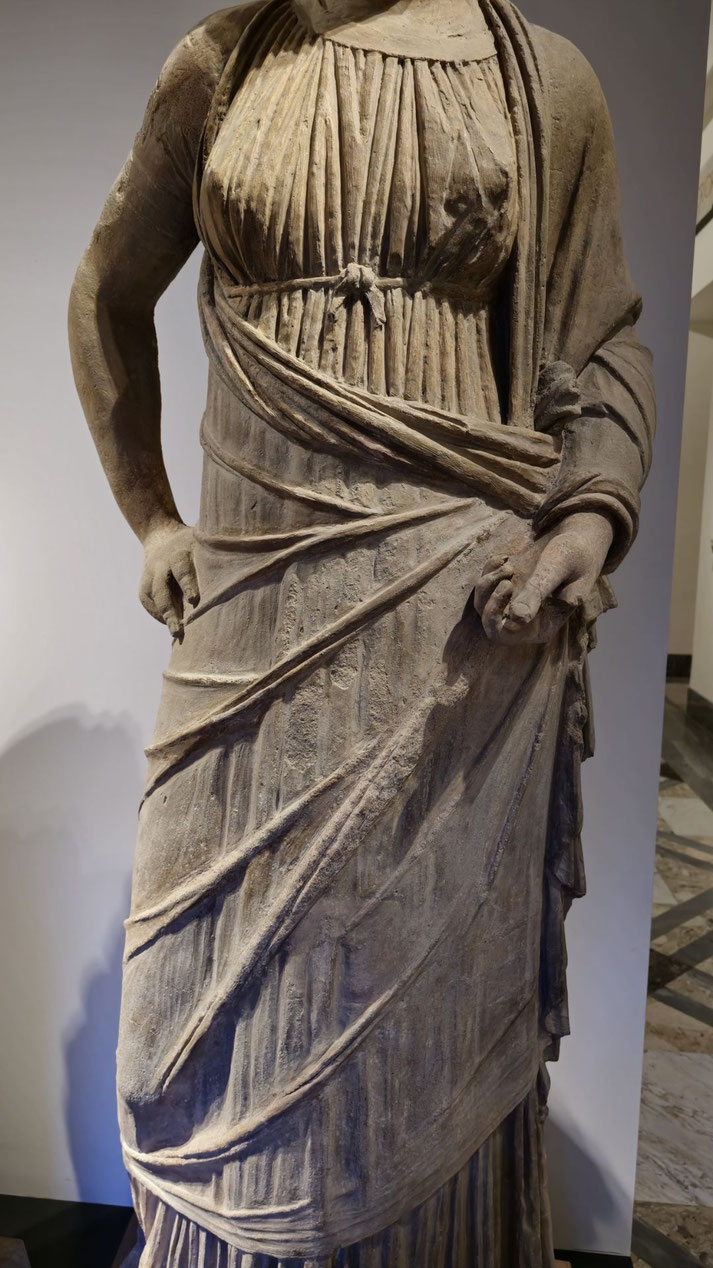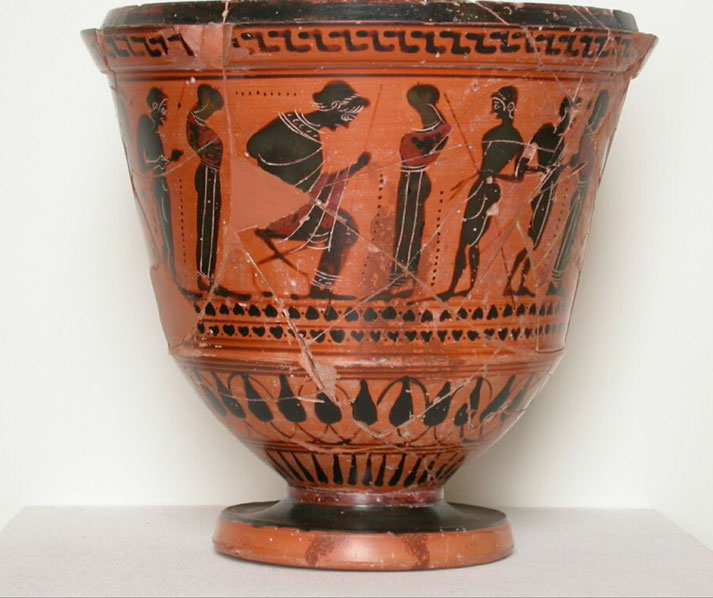What clothes did people wear in ancient Greece?

When Athenian women put on their clothes before leaving home, they were expected to follow the rules of proper behaviour. Actually, almost all people in their culture had to abide by very clear guidelines about what they wore.
This is because ancient Greek clothing did much more than just keep people covered. In fact, it was an important way that they showed different social roles whcih maintained their social order.
So, how did these clothing choices affect the roles people had in daily life?
What materials were ancient Greek clothes made from?
On a very basic level, the materials the ancient Greeks used to make their clothes depended on what was available locally.
For example, the main fibres they used were linen, which came from the flax plant, and wool, whcih came from sheep. These were very common in many parts of the country.
Linen felt cool and lightweight, so it was helpful in the hot Mediterranean summers.
In contrast, wool kept people warm in colder months and could be spun into thin or thick threads.
However, the process of making cloth from these elements required a lot of work and skill.
First, they harvested flax stalks and soaked them in water until the fibres separated from the stems.
Next, they pulled the fibres apart, twisted them into threads, and wove them into linen cloth on looms.
Wool went through similar steps. The workers cleaned and combed the wool to line up the fibres before spinning.
After weaving, they often washed wool cloth to make it thicker and softer.
Therefore, a single garment could take weeks to create from the time of harvest to the time it was ready to put on.

It was the women in each household that were usually responsible for making the garments.
Thankfully, they did not need to cut the cloth much; instead, they draped rectangular pieces over the body and fastened them with a belt or a pin.
This approach let wearers move easily while staying covered.
The most common clothes ancient Greeks wore
Ancient Greeks wore a few basic garments that were primarily designed for comfort and appearance.
The chiton was a simple tunic worn by both men and women. For example, men’s chitons reached the knees while women’s chitons reached the ankles.
To make one of these, they folded a rectangle of cloth around the body, held it at the shoulders with pins or brooches, and tied a belt at the waist.
In addition, the peplos was a garment only for women that resembled the chiton but was made from heavier cloth.
Women folded one edge of a peplos down before wrapping it around the body to create a flap called an apoptygma, and after tying it at the waist, the peplos looked like it had two layers.
When required, they could adjust the apoptygma to adjust for temperature, or simply for comfort.
For those that wanted to, or could afford to, they could have peploi feature particular decorative patterns or embroidery.

The himation was a large cloak worn over the chiton or even by itself. People draped it over the left shoulder and wrapped it around the body to leave the right arm free for movement.
It was useful for warmth in coller months, or even for modesty. Everyone seemed to have worn one; however, its material and how it was draped could change depending on a person's social status.
For an outer layer, Greek men often wore the chlamys, a shorter cloak pinned at the right shoulder.
Meanwhile, soldiers and young men chose it so that they could move easily when they carried swords at their waists.
It was also a practical choice for travel and riding horses. And, since soldiers commonly used it, the chlamys became a symbol of bravery and strength.
How clothing changed for rich and poor
In ancient Greece, attire clearly showed a person’s place in society, with the quality of fabric, detail in design, and use of dyes or decorations all indicating social status.
For instance, wealthy Greeks could afford finer textiles such as soft, thin wool or imported linen that felt nicer and looked better.
They also used bright dyes that were costly and laborious to produce. One example is the purple dye from the murex snail, which required about 10 000 to 12 000 snails to yield one gram of dye.
By the Hellenistic period, silk from China also became a prized possession for the upper class, whereas cotton stayed rare on the mainland until later.

For example, longer chitons belonged to people who did not do manual work whereas shorter chitons suited workers who required ease of movement.
Likewise, a himation with many folds showed that the wearer did not perform hard labour, whereas a plain, undyed himation was common for ordinary citizens.
Even city governments recognised attire as a status marker; in Athens, for example, laws sometimes limited the use of precious metals or certain colours in dress to prevent ostentation and keep luxury clothing for the wealthy.
Jewelry, shoes, hats, and other accessories
Ancient Greek footwear remained simple and practical but could also show one's wealth and importance.
Sandals were the most common choice, and usually featured a flat sole held to the foot with thin leather straps.
While most people wore plain sandals for everyday use, the wealthy chose more decorated designs with metal ornaments or carved motifs.
Full boots tended to appear in colder weather, during travel, and in professions such as horse riding, when it was important to cover more of the foot and ankle.
In additiona, they could wear a petasos, a wide-brimmed hat, to protect from the sun.
It was most often selected by travellers and hunters, and most sources say it consisted of felt or leather, although straw versions appeared later.

Jewellery was very important in Greek dress. Both men and women wore earrings, bracelets, necklaces, and rings crafted from gold, silver, bronze, and semi-precious stones.
Many pieces depicted gods, goddesses, or mythological scenes, which meant that wearing jewellery displayed religious devotion or hope for spiritual protection from danger.
In many city-states, a woman’s jewellery formed part of her personal property or inheritance, but in places like Sparta, women kept their jewellery even after marriage.
Belts and girdles remained common for securing garments. They could be simple leather straps or decorated cloth pieces with metal accents.
Just like today, these gave shape to the body and allowed wearers to adjust how garments fit.
Additionally, people used hairpins and brooches to secure clothes or hairstyles while adding ornamentation.
Did ancient Greek clothing have patterns or colors?
Patterns and colours gave ancient Greek garments a unique look and meaning, as designers often used simple geometric designs like checks, stripes, and meanders.
Weavers could also incorporate these motifs into cloth or artisans might add them later with embroidery along edges.
Dyemakers used colours that were dreived from plants, minerals, and sea creatures.
They obtained red from madder root, yellow from saffron, and blue from imported indigo.
Bright colours frequently signalled wealth because producing them required substantial resources and labour, whereas white remained the natural colour of linen and wool.
Craftsmen could add colourful and detailed borders or hems to depict mythological scenes, nature, or daily life.
Some officials even wore special embroidered vests for ceremonies.
What is more, artisans employed pleats in cloth to add volume, allowing light and shadow to play on the fabric and making movement appear more dynamic.
How ancient Greek clothing styles changed over time
In the early periods, such as the Minoan and Mycenaean civilizations which flourished between 2000 to to 1100 BCE, garments fit the body closely to emphasise the human form, which is evident from frescoes at Knossos and Pylos and painted pottery illustrating those styles.
The Minoans favoured layered skirts and fitted bodices, but later, artisans simplified these into draped styles linked to classical Greek fashion.
As Greek society transitioned into the Archaic and Classical periods, men and women adopted garments such as the chiton and himation, with the early Doric chiton consisting of a plain rectangle of wool fastened with pins at the shoulders.
By the fifth century BCE, the Ionic chiton appeared, which was crafted from light linen and held with small brooches along the upper arms to create a sleeve-like effect without actually having sewn sleeves.
The Hellenistic period brought further changes, influenced by the expansion of the Greek world and the cultural exchanges that came with Alexander the Great's conquests in the 4th century BCE.
Eastern styles reached Greece during this time; for instance, at court, they used thin, translucent textiles and fine weaves from regions like Persia and India, and silk from China became a marker of elite status.
Garments became even more frequently detailed, featuring layers, sewn hems, and pleats that enabled better draping.
Even after the Hellenistic period, Greek attire influenced Roman dress; for example, the toga evolved from the Greek himation, and Roman cloth makers adopted weaving and dyeing methods from the Greeks.
What do you need help with?
Download ready-to-use digital learning resources
Copyright © History Skills 2014-2025.
Contact via email
With the exception of links to external sites, some historical sources and extracts from specific publications, all content on this website is copyrighted by History Skills. This content may not be copied, republished or redistributed without written permission from the website creator. Please use the Contact page to obtain relevant permission.





